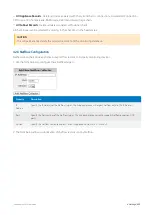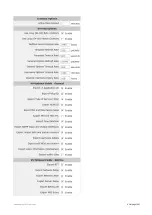
Exinda Network Orchestrator
4 Settings
|
462
NOTE
The status field is shown as
growing
whilst the resize operation is in progress. When the operation is complete,
the status will change to
available
.
Now use the remainder of the disk (approximately 574.79G) to incurease edge-cache to 706.71G (or 723671.04M).
(config) # storage service edge-cache size 723671.04M(config) # show
storageServices: cifs: available - 859.88M free of 1024M total edge-cache:
available - 695.43G free of 706.71G total monitor: available - 196.42G free of
200G total users: available - 974.62M free of 1024M total virt: available -
363.91M free of 512M total wan-memory: available - 4879.63M free of 5120M
totalDisks: sda9 (internal): in use - 914.22 GBTotal: 219.02GUnallocated: 12M
The status field can be referred while the resize operation is in progress. When the operation is complete, the status will
change to available.
NOTE
HDD manufacturers label storage capacity using a base 10 convention, where 1GB = 1,000,000,000 bytes. On the
Exinda appliance storage sizes are represented in GiB, where 1 GiB = 1,073,741,824 bytes. So the actual storage of a
hard disk, when represented in GiB, is less than what is labeled.
4.3 Certificates
Learn managing the certificates and CA certificates that the Exinda Appliance(s) must use to decrypt and re-encrypt the
traffic that is flowing into and out of your network.
4.3.1 Managing Certificates and CA Certificates
4.3.2 View all certificates and private keys
4.3.1 Managing Certificates and CA Certificates
When accelerating encrypted traffic, the Exinda appliance transparently decrypts the traffic, performs the relevant
application acceleration techniques, such as TCP Acceleration, WAN Memory, or Edge Cache caching, and then re-
encrypts the traffic. The Exinda appliances must have access to the appropriate certificates or certificate authority (CA)
certificates, and the public keys to decrypt and re-encrypt the traffic. You can import a certificate or a CA certificate, or
generate a self-signed certificate or CA certificate.
On the Certificates tab, you can import normal certificates and you can generate untrusted self-signed certificates. Note
that the normal certificates may be trusted Certificate Authority (CA)-signed certificates or self-signed certificates. In the
Certificates and Keys
table, you can see a list of all the (non-CA) certificates available on the appliance. You can show,
delete, or export any of these certificates.
On the CA Certificates tab, you an import CA certificates and you can generate untrusted self-signed CA certificates. By
importing CA certificates, the appliance can offer the entire chain of trust to clients when performing an SSL handshake.
In the
CA Certificates and Keys
table, you can see a list of all the CA certificates available on the appliance. You can show,
delete, or export any of these certificates.
Summary of Contents for EXNV-10063
Page 369: ...Exinda Network Orchestrator 4 Settings 369 ...
Page 411: ...Exinda Network Orchestrator 4 Settings 411 Screenshot 168 P2P OverflowVirtualCircuit ...
Page 420: ...Exinda Network Orchestrator 4 Settings 420 Screenshot 175 Students OverflowVirtualCircuit ...






























